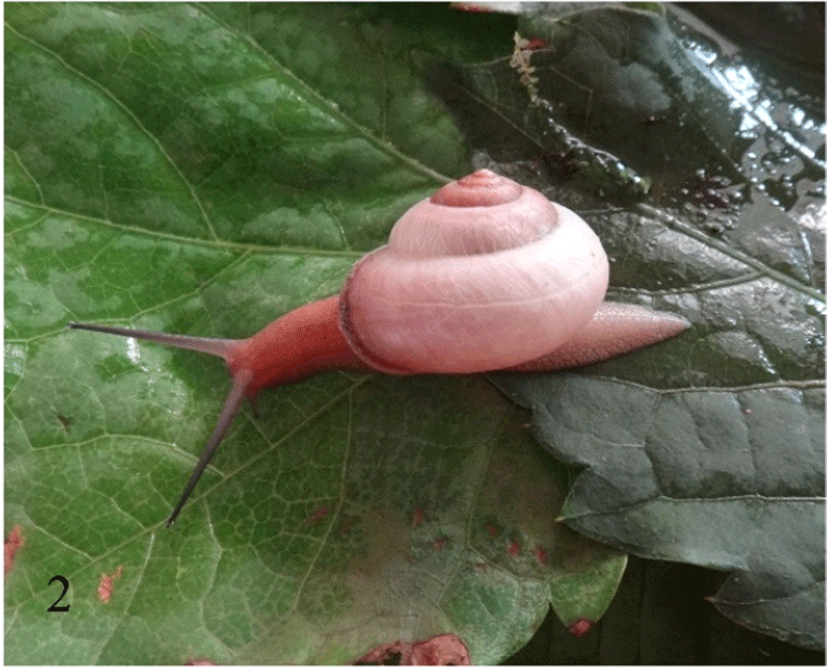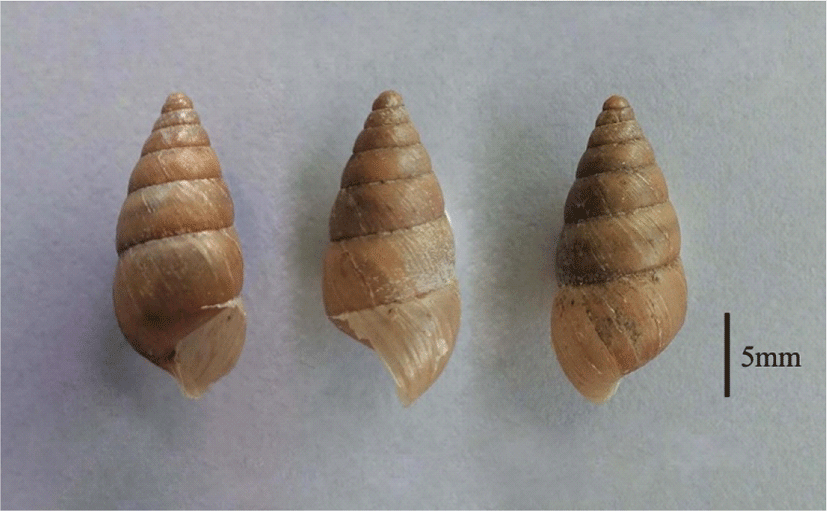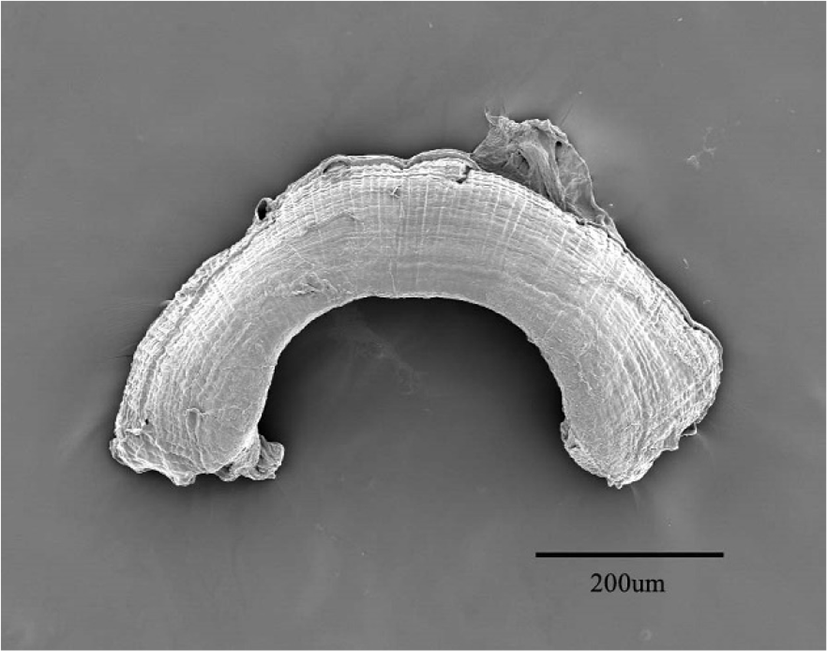INTRODUCTION
The mollusca are one of the great groups of the animal kingdom. Molluscs range from limpets clinging to the rocks, to snails which crawl or dig or swim, to bivalves which anchor or burrow or bore, to cephalopods which torpedo through the water or lurk watchfully on the bottom. They penetrate all habitats: the abysses of the sea, coral reefs, mudflats, deserts and forests, rivers, lakes and underground. They may become hidden as parasites in the interior of other animals. In number of species, the Mollusca are the second largest animal phylum on Earth after arthropods: it is almost impossible to assess accurately the total of species. In most mollusks, the characteristics of shell are different for each species. Therefore, the characters of the shells are very important in species recognition and usually for generic and familial placement as well. Especially useful are the adult size and general form of the shell. Among the many species, the shell may take various shapes, yet, for any one species, the shape is usually quite constant (excepting, of course, individual differences and minor clinal, populational and ecophenotypic variations that may be exhibited by some species). In recent years, many changes and additions have been made in the general classification of the Phylum Mollusca. Research is uncovering hitherto unsuspected affinities and rejecting others, not only in individual groups, but in the higher categories. Many groups have not as yet been investigated thoroughly, or are in the process of being re-examined in the light of new methods of identification and classification.
Until recently, 23 species, 11 genera of Bradybaenidae and 6 species, 3 genera of Calusiliidae of gastropods were reported in Korea (Kwon et al., 2001). The Bradybaenidae, Calusiliidae and Hydrobiidae in gastropods contain numerous species with rather subtle specific shell characters and the soft part anatomy is also an important diagnostic criterion. Also, the Corbiculidae in bivalves have been reported six species of Korea so far (Kwon et al., 1993). Globally, Hydrobiidae are one of the most common and widely distributed gastropod families, occurring in temperate, subtropical and tropical regions throughout much of the world. The family is a large one, containing more than 100 genera. However, to date, no species in the Hydrobiidae has been reported in Korea. This is the first time that a species belonging to this family is reported in Korea. Shells of Hydrobiidae snails are small (many are minute), generally elongate, dextral, nearly always drab and unicolored, and generally have relatively few whorls. Because of the similarity of the shells of many species occurring in different genera and subfamilies, reliance must be placed on anatomical characters, especially those of the verge (male copulatory organ), in making identifications and for assigning species to genera (Burch & Jung, 1992). This paper described a new species and a new record collected from Korean peninsula. All type material has been lodged with the Laboratory of Environmental Medical Biology, Catholic Kwandong University.
MATERIALS AND METHODS
The specimens were collected and directly bring to the laboratory. The shell was removed with tweezers. Care was taken not to damage the soft parts. Genitalia were dissected and examined under a Nicon XMZ 800N stereo microscope (Nicon, Japan). The radula morphological features were examined with the aid of a scanning electron microscope (SEM). The radulae samples extracted and cleaned in KOH, rinsed in distilled water and 96 % alcohol, were mounted on stubs, sputter-coated with platinum and then documented using a digital Scanning Electron Microscope FESEM observation (Field Emission Scanning Electron Microscope, FEI, Inspect F, Brno, Czech Republic). Subsequently, photographs were taken at various magnifications depending on the size of the radula. Radula length and width were measured from the photographs. The terminology used in the description of radula follows Kool (1987). Voucher specimens are deposited in the Laboratory of Department of Environmental Medical Biology, Catholic Kwandong University, Korea.
Description of New Taxa
Phylum Mollusca Linnaeus, 1758
Gastropoda Cuvier, 1797
Order Eupumonata Haszprunar and Huber, 1990
Family Bradybaenidae Pilsbry, 1934
Genus Koreanohadra Kuroda and Habe, 1949
Koreanohadra kurodana fomosa n. sp. 고운달팽이 (신칭) (Fig. 1~3)



Material examined: Korea: Gyeonggi-do, Dongducheon-si, Soyo-dong, Soyosan
Diagnosis: Body whorl height and width are 25 mm and 33 mm. Shell is globose, spire conic and rather depressed; solid not thick; as a whole yellowish brown in color, from the penultimate whorl to the apex dark brown color, fading to a tincture of reddish brown just below the suture and at the umbilicus. Shell surface smooth, with fine spiral growth line, under side with fine growth line, flatted. Whorls 6, each whorl moderately convex, shell with regularly increasing whorls, the last whorl wide, rounded, convex beneath, slowly and slightly descending in front. Sutures are moderately deep. The aperture is oblique, broadly lunate. Peristome is thin, expanded and narrowly reflected, brownish, pale at the edge, expanded and towards the columellar insertion, partly covering the umbilicus.
Remarks: This species is endemic species in Korea and type locality is Mt. Soyo near Seoul. Koreanohadra kurodana (Pilsbry, 1926) is apparently very close to this species, but differs from it in the large shell, thick, and narrower umbilicus. Shell is yellowish brown in color and dark brown color in apex. Koreanohadra kurodana (Pilsbry, 1926) have encircled with a chestnut brown band above the periphery, however this species is not, also this species have 6 whorls instead of 5 1/2 whorls of K. kurodana.
Habitat: Humid soil on the ground and under fallen leaves
Koreanohadra koreana jangdoensis n. sp. 장도참달팽이 (신칭) (Fig. 4~6)



Material examined. Korea: Jeollanam-do, Shinan-gun, Heuksan-myeon, Jangdo
Diagnosis: Shell: large, 26 mm in diameter and 19 mm in height with 4 1/2 whorls, thin, depressed-globose, with low conic spire, moderately solid though not thick, yellowish brown in color. Surface sculptured throughout with almost regular striae of growth and minute incised spiral lines, the first whorls nearly smooth. Whorls moderately convex, shell with rapidly increasing in size. Body whorls rather large, occupying about 73% of shell height. Sutures are moderately deep. The aperture is oblique, broadly lunate. Peristome is thin, expanded and narrowly reflected, yellowish the edge, expanded and whitesh yellow towards the columellar insertion, covering the umbilicus not covering.
Remarks: Daejangdo is an island about 2 km west of Heuksan Island. There is a large wetland inhabiting various benthic species in the basin of 180-200 m above sea level and registered as Ramsar site in 2005. It is an island 22 km away from Hongdo island, the habitat of Koreanohadra koreana (Pfeiffer, 1850). This species is endemic species of Korea. Habe and Lee (1958) are re-established type locality of Koreanohadra koreana, Hongdo in Jeollanam-do. Koreanohadra koreana jangdoensis is apparently very close to K. koreana species, but differs from it in the medium shell, lower conical form, narrow umbilicus, not oval shape of aperture, and no covered in outer lip of the last whorl.
Habitat. Under leaves of stone wall or field in near house
Genus Acusta Albers, 1860
Acusta despesta agada n. sp. 아가다달팽이 (신칭) (Fig. 7~8)

Material examined. Korea: Jeollanam-do, Shinan-gun, Heuksan-myeon, Hongdo
Diagnosis: The shell height 23 mm, diameter 25 mm and aperture including peristome width 16, height 13 mm. Shell is globose, spire conic and somewhat elevated, thin easy to fragile, light brown, semi-transparency, dull glossy. Shell surface with irregular growth lines, lower surface marked with fine, inconspicuous and very strong peripheral growth line. Whorls 5 1/3, convex with distinctly impressed suture. The succeeding whorls are gradually increasing diameter towards aperture, the last one slightly descending in front. Body whorl length is 18 mm, occupying about 80% of shell height, well rounded at the periphery. Aperture is large, roundly ovate. Peristome thin, sometime columellar lip reflected, columellar portion partly covering the umbilicus. Dart sac lager than accessory dart sac and, mucous glands in small globulla, situated between the accessory dart sacs and occurred downward. Vagina is rather swelled, short, at terminal region divided into oviduct and stalk of receptaculum. Oviduct connected to large hermaphrodite duct, uniform thickness and connected albumen gland. Penis sheath is long, somewhat thickening distally connected epiphallus, without flagellum.
Remarks:Acusta despesta agada collected from Hongdo in Jeollanam-do is very close to Acusta despecta sieboldiana, but differs from it in the large and smooth shell, higher conical form, narrow umbilicus, oval shape of aperture, and no covered in outer lip of the last whorl, larger aperture, and clear growth lines in aperture. Also, Chosenelix prnoblematica (Pilsbry, 1926) is apparently very close to this species, but differs conical form and with irregular growth lines. Acusta despecta sieboldiana is distributed nationwide.
Habitat: Grass of cyperaceae plant
Family Bradybaenidae Pilsbry, 1934 (1898)
Genus Pseudobuliminus Gredler, 1886
Pseudobuliminus muleung n. sp. 무릉달팽이 (신칭) (Fig. 9~12)


Material examined. Korea: Gangwon Province, Samhwa-dong, Donghae Jeolmitkkol
Diagnosis: Shell: 18.8mm in shell length, 8.0 mm in shell width; High turreted in shape, white brownish coloured shell with obtuse apex; Whorls 7 in number; Each whorl convexious; Surface lustrous, sculptured with fine, oblique wrinkled striae; Aperture small (5.8 mm high, 4.0 mm wide), sub-diagonal, lunate-round with simple peristome, insertion of columellar lip shortly, distinctly reflected; Umbilicus opened narrowly; Penial sheath well developed, uniformly large in diameter; Epiphallus also developed and junction between penial sheath and epiphallus is conspicuous due to constriction; Retractor muscle attached on posterior one third of epiphallus; Radix of spermathecal stalk was formed as large bulloon shaped swelling which extended from posterior of vagina just near insertion of oviduct; Radula ribbon 4.5 mm long, 0.68 mm wide; Radula teeth formula is 13M+9L+1C; Cusps of lateral and marginal teeth become oblique and similar size; have bicuspid lateral teeth.
Remarks:Pseudobuliminus muleung is first described with specimens from Korea. The reproductive system and radula of P. coreana are reported here for the first time with description of its shell. This species should be include at the genus Pseudobuliminus or family Bradybaenidae due to dart sac and mucous gland on its reproductive system. Genus Pseudobuliminus was settled by Gredler (1886) for land snail which of light winding, high turret shape shell from Far East Asia. Anatomically the new species differs from any other Pseudobuliminus species in having a very long epiphallus, all divisions of penial appendix are clearly defind. Spermathecal reservoir is rather strongly inflated.
Habitat: Humid soil on the ground and under fallen leaves
Family Calusiliidae, J.E. Gray, 1855
Genus Paganizaptyx Kuroda, 1945
Paganizaptyx miyanagai guryongsan n. subsp. 구룡입술대고둥 (신칭) (Fig. 13, 14)


Material examined. Korea: Chungbuk, Boeun-gun, Hoein-myeon, Ssang-am-ri, Guryongsan
Diagnosis: The shell is corneous or greenish brown and finely ribbed and with fine striae except the first three whorls; 11 whorls with first three forming a cylinder sacrcely one mm in diameter; The apertural margin is detached; Columellaris is deep inside and forked, hardly visible in a perpendicular view; Palatal wall is white and prominent; no lunula; Sub-columellaris is very close to basal furrow, visible in an oblique view; Clausilium is not very concave; The width of the shell is 2.8-3.1 mm; The height of the shell is 178.3-189.7 mm; This species is very exacting on the quality of its environment and its populations are small and quite scattered in the whole of its range; They lives old-growth forest with fallen dead wood (coarse woody debris) in montane and submontane; It is found in humid and shady habitats in woods, underground litter and stones, in mountain.
Remarks: Only three Paganizaptix are found in Korea: P. miyanagai, P. miyanagai ullungdoensis and P. miyanagai guryongsan. They are very similar shape, but next features are different of this subspecies from P. miyanagai and P. miyanagai ullungdoensis: medium, long cilindric in general appearance, 11 whorls, thick axial striae, large aperture, shape of principal plica and palatal plica.
Habitat: Crack in the stones or fallen leaves under the tree.
Family Hydrobiidae Troschel, 1857
Genus Holsingeria Hershler, 1989
Holsingeria unthankensis new record 왕피동굴우렁이 (신칭) (Fig. 15)

Material examined. Korea: Gyeongsangbuk-do, Uljin-gun, Geunnam-myeon, Noeum-ri, Seongryu cave collected by Yong-Gun Choi
Diagnosis: Shell is tiny, pale-colored, stream-dwelling snail inhabiting undersides of stones in cave, 1.5-2.0 mm high; height/width, 188-225%. Whorls, 4.5-5.0, rounded, shouldered above. Spire outline convex, body whorl 40-50% of the shell height. Translation rate high, 6.5-8.0; whorl expansion rate moderate, 1.0-1.5. Aperture nearly circular, expanded, thickened all around, usually slightly separated from body whorl. Adaxial and abaxial sides of aperture advanced (yielding sinuate appearance of outer lip), inner lip somewhat reflected. Umbilicus moderately open. Protoconch rounded, protruding, with about 1.5 whorls. Swellings weak beyond first teleoconch whorl, usually entirely absent from body whorl. Collabral growth lines well-developed, particualrly on body whorl. Animal with 4.5-5.0 whorls.
Remarks: The presence of this species may be revealed in other Korean cave surveys in the future.
Habitat: This species is thus far known only from the small cave stream in Seongryu cave.
Phylum Mollusca Linnaeus, 1758
Class Bivalvia Linnaeus, 1758
Order Venerida Gray, 1854
Family Corbiculidae Gray, 1847
Genus Corbicula Megerle von Muhlfeld, 1811
Corbicula amnis n. sp. 동강재첩 (신칭) (Fig. 16~18)

Material examined. Korea: Gangwon-do, Yeongwol-gun, Yeongwol-eup, Bangjeol
Diagnosis: Body length 14.8-15.4 mm, height 12.8-13.5 mm, width 10.0-10.7 mm; Clams have thick, triangular shells with deep and very distinctive growth rings; They are typically small, averaging less than an inch in diameter, with the largest individuals rarely exceeding one inches; Shells can be pale brown to yellowish brown to a darker brown in color; The inside of the shell can be pale white to a deep purple or yellowish; Young shells (juveniles) have distinct white lines on dark brown background; Afterwards it gradually fades and black remains only on the posterior and anterior of the shell; Centrally located beak or umbo on shell; The umbo is a protuberance beside the dorsal margin of each valve; The umbo is displaced slightly toward the anterior end of the valve; Knowing dorsal and anterior find right, left, ventral, and posterior; In the center of the hinge, immediately ventral to the umbo, are the cardinal teeth; In Corbicula there are three cardinal teeth in each valve and they are easily recognized because they look like teeth; Many, coarse concentric rings on outside of shell. 2 pair long, finely serrated lateral “teeth” per side on right valve: 1 pair per side on left valve. 3 pseudocardinal “teeth” per valve; Associated with the adductor muscle scars are scars of the pedal retractor muscles that withdraw the foot into the shell before the valves are adducted. Interior of shell yellowish with polish.
Remarks: The corbiculidae are a widespread family of moderate sized clams, often tinged or colored with violet on the interior. The name “corbicula” (little basket, from corbus, basket) refers to their characteristic concentrically ribbed shells and general shape. They are ovoviviparous, brooding internally fertilized eggs in brood pouches. Brood size is large, but the juveniles released into the surroundings are tiny. To date, seven species (Corbicula fluminea, C. fenouilliana, C. leana, C. papyracea, C. colorata, C. portentosa and C. japonica) in family Corbiculidae are known in Korea. In Korea, Corbicula species is more widespread, occurring in all habitats from small creeks to large reservoirs, while this species seems restricted to certain fast-flowing rivers at this time. Their morphological differences are consistant, allowing a set of specimens to be sorted with little ambiguity. Corbicula fluminea and C. leana have fine concentric rings on the shell from juvenile to adult, compared to C. amnis new species. Periostracum color is not particularly diagnostic, as in most locations small young ones are greenish yellow, and they slowly darken as a function of age and water chemistry. However, the characteristic feature of this species is the shell from the young to the adult (Figs. 16, 17). And, after a certain growth is characterized by having an umbo in the shell (Fig. 18).
Habitat. Fast-flowing riverine systems, where it prefers areas with sand and gravel substrates.











